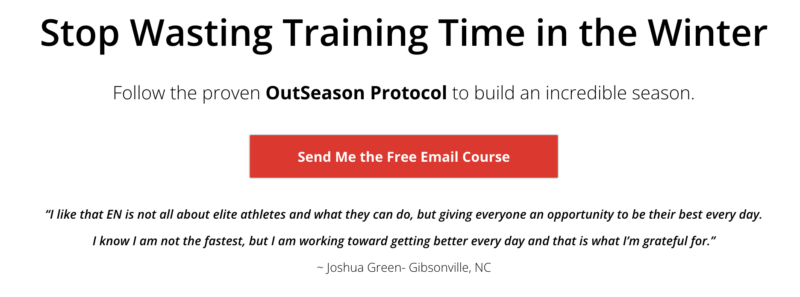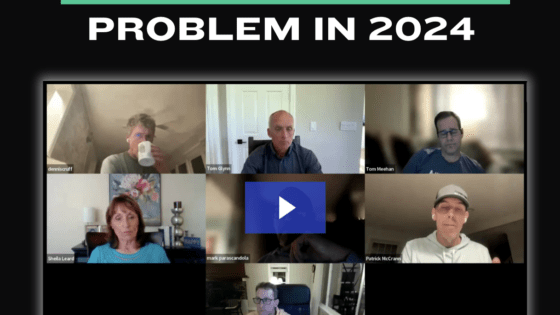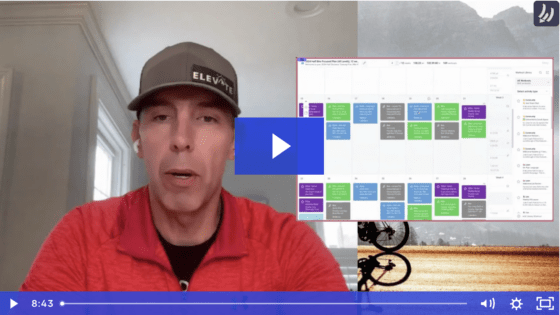It’s Fall and time for another annual rewrite of our OutSeason® training plans.
It’s also the season of the recycled, paraphrased training advice that appears in the tri mags year after year as Coaches try to catch your attention— by telling you the same advice that everyone else is telling you, apparently.
We do things differently. Our nearly 20 years of Ironman® coaching experience and interactions with a team of over 500 long course triathletes forces us to step back and think long and hard about things like:
- What is time return on race day for every training minute we ask our athletes to invest?
- Is the cost of that training time constant across the year, or variable? That is, more expensive at certain points in the season?
- When is the best time of year to make our athletes much faster on race day?
We’ve captured these ideas, and much, much more, in our OutSeason® plans, used by more than 12000 age group triathletes just like you since 2009. We you haven’t already done so, we encourage you to redefine how you think of fitness and endurance training.
But that’s us talking.
We’d now like to share with you the thoughts, observations, experiences, and results of our athletes in our OutSeason® training program. We asked them four questions and below are their answers:
How did you to train in the OS, before EN?
“Nothing too formal, to be honest I wasn’t real serious but was told by old coach to MTB, do some running, nothing formal. Mainly low z1 work.”
“I had a one on one coach for 3 years before EN. OS consisted of the “Training Bible”/Joe Friel base building. About 3-4 runs a week—when I trained with HR, all at zone 1. No intervals. When my coach went to training with pace, those runs were done at Epace–which was determined by HR as there was no run testing. About 3-4 rides on the trainer a week—also at zone 1-2 with some one legged drills and spin-ups. No intervals. The peak longest ride was 2.5-3 hours on the trainer for me as it was Feb and March when the base building volume was its highest. When my coach went to training with a PM, I did one test at the start of the OS then did a few intervals at 85% (called “The Sweet Spot Ride”). There was no testing again for the rest of the season or any guidance with how to pace an IM or HIM with the PM. 3-4 swims a week: with 100 and 400 IM sets (as in fly, back, breast, free) with IM drills (breast kick drills, one armed fly drills) with sets of 200, 300 pull with buoy and paddles, 100-400 sets at T-pace or descend for a total of 2800-3200 for each swim. The peak amount of time per week was 15-17 hours.”
What do/did you do differently in the EN flavor OS?
“Obviously it was structured so I followed EN protocol. High intensity work on the bike and run. No swimming.”
“NOT SWIM! Hallelujah!!! Test for run and bike, use that test to set training zones, train at FTP, 120%FTP, tempo pace for the sole purpose of increasing FTP and Vdot. Simply, I trained to get FAST…in the most time efficient way possible. I learned what hard work really was…which has made me not just physically, but mentally stronger. I saved myself from going crazy from not doing 3 hour trainer rides and IM drills in Feb.”
What changes/gains/results did you see in your training, racing, and self-coaching knowledge?
“When the weather was nice enough to ride outside with friends they all noticed how much faster I was on the bike. Only real comparison racewise would be a 21 minute improvement in a long sprint race. FYI, this result was the same weekend as a HIM RR and another 20 mi ride so legs weren’t firing like I would have liked them to.”
“In my first OS, I had a 38% gain in my FTP and a 4 point increase in my Vdot. Despite not swimming all OS, after 4 weeks of doing Coach Rich’s swim drills, I was swimming just as fast as I did when I went to Masters 4 times a week and way faster than when I did those stoopid IM sets. I finally have a grasp of what a powerful tool my powermeter is for training and racing. I can know make reasonable decisions (when my ego is in check) about my training schedule as a self-coached athlete.
What would you tell a training partner who is considering the choice between Old Skool and EN OS?
“Basically results speak for themselves. 15% gain on the bike in 20 weeks.”
“If you are interested in training smarter and more efficient, if your ego isn’t wrapped around training 20+ hours a week “like the pros”, if you want to execute to the very best of the fitness that you bring to race day…then EN is the way. It is the most time efficient method to squeeze out as much fitness from your body while preserving your sanity, home life, and job. Even if I won the lottery, didn’t have work or clean my bathrooms ever again and had OODLES of time on my hands, I would still train the EN way. It just makes sense.”
Other observations from our athletes
(sorry, they didn’t specifically answer our questions 🙂
“While I was attracted to EN by their race execution philosophy, I’ve since learned that the emphasis on “minimize time, maximize value” of each workout has value not just for the time-crunched athlete, but also for someone like me, who is both a veteran trainer and an older athlete (two different concepts; veteran is someone with at least 5-7 years of consistent long-course training under his/her belt; older is whatever age you want to use, probably somewhere north of 50-55). For the vet who still wants to improve, and probably has years, if not decades of “base” in biking and running, doing more volume will probably not help very much. EN’s focus on more intensive, shorter efforts, especially in the Out Season, offers a route to faster times on the race course. And for the older athlete, who probably has signficantly more need for recovery, doing less volume provides that opportunity. While top end speed is probably less in the older athlete, we still have opportunities to mazimize our potential through judicious use of short, intense intervals. The EN program, designed for the “time-crunched” athlete, fits the bill nicely for different reasons for the older athlete, who might not necessarily be time-crunched, but whose ability to fit in massive amounts of training is restricted by other factors, such as injury, slower healing times, and reduced hormone levels (e.g., HGH, testosterone.) I haven’t yet gone through a full season on the program, but I do have one OS and one IM result so far. No question, as a life-long swimmer, I was anxious about de-emphasizing that aspect of my training life. I saw NO dropoff in my swim race times, however. And, my IM result was quite satisfying – on a very warm day (temps up to low 80s), I bettered my time from the year before by six minutes, when the temps had been in the 50s, by six minutes, and could have gone even faster if I’d had a reason to – I won my AG by 10 minutes, and just cruised my run home! At my age, keeping my times the same from year to year I regard as a big accomplishment, to say nothing of getting better.”
“I’ll offer some of my thoughts having been doing this for about 7 years and starting with the Triathlete’s Training Bible back in 2003. TTB (at least the version I worked with) emphasized true Old Skool techniques (large volume with significant time in heart rate Z1-Z2). I was trying to log upwards of 16-20 hrs/week (this was less than advocated by TTB, but was all I thought I could manage working full time and being married… fortunately, no kids at that time) in the “offseason,” and was frequently doing 5-6 hr rides and 2-2.5 hr runs on the weekends while cramming in 10,000 meters of swimming (again, less than advocated by TTB) and additional bikes/runs during the week. My goal was IM Wisconsin in 2004, and I did very well for me, finishing in 12:27, (~1:10 sw / ~6:10 bike / ~5:00 run). After that, I wanted another shot, because I thought I could do better. I switched from TTB to “Going Long” (Gordo Byrn) which was similar, but offered a few differences. a month or so before my second shot at Moo in 2007, I switched to Crucible Fitness with Rich just as EN was being launched. I listened to R&P’s advice, but didn’t heed it. I was one of the morons walking the marathon talking about my great (for me) bike split en route to a 6 hour ego death march (and puking at mile 22) on the marathon. For 2007, my (mostly) Going Long training again averaged in the 15-20 hrs/week and netted me 1:12 sw / 5:50 bike / 6:00 run and a disappointing finish, although I wonder if I’d have done better with better execution, because I think the fitness was there. FFW to 2010 as I was training for IMLP. With 3 more years of EN under my belt, my training volume had significantly dropped. I was now taking months completely off from swimming while focusing on the bike and run (although my run focus has been shaky at best). My average training hours are way down (maxing at about 12… maybe). At LP, I PRed in 12:12:27 (1:13 sw / 6:11 bike / 4:35 run). This result came after virtually no swimming until 12 weeks out, and then only 2x/week (total of 5Km-6Km), even when the Race Prep called for 3x/wk, and I was exactly 3 minutes off my BEST IM swim trying to cramalmost twice as much swimming into a week. In addition, I really didn’t follow the run portion of the plan this year. I ran rather infrequently, but trying to hit the long runs. When I DID start hitting more runs (about 6 weeks out) I didn’t hit a lot of the interval work prescribed, but rather, ran pretty steady. I still PRed my marathon run by 25 minutes. What I DID do was hit almost every bike workout at the prescribed wattages. These plans work to keep me in great shape at half the time of Old Skool plans. I’m eager to find out what I can do if I really apply myself to ALL aspects of the plans, and I’m now working to improve my running. With easier access to the pool later this year and a renewed interest in running, maybe I can finally hit all aspects of the plan and see where it can take me at the Half IM level.”
Swim- technique focus.
Drills, drills, intensity and out of the pool. No slogging away for slogging’s sake. I really enjoy swimming now because I have a fundamentally sound stroke. Everything else takes care of itself. My fitness comes from the bike and run.Bike- power focus.
Intervals. My friends want to go for 5 hour rides and I join them only for 3.5 but they know the 3.5 is going to have some tempo. They can wander and noodle for another 1.5 if they want to, but I’m out unless it’s a century ride or has some other purpose or focus or mission.Run- see both above, technique and power (pace). Improved form allows me to have volume and frequency, injury free. Intervals focus my efforts and push my zones.Aside from seeing my splits improve in all three categories, the biggest gain for me has been in the area of balance. I can do the training in an efficient and focused manner, recover properly and then go do life. Living a monomaniacal triathlete lifestyle has never been possible for me. There’s too much else to do.”





Leave a Reply